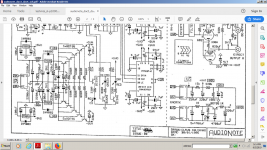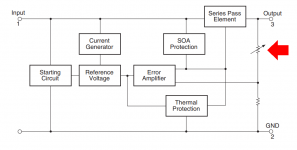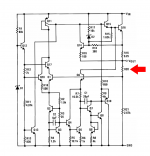Except that this buffer was used in their best and most expensive products:
slp-2000, slp1200, slp 1000, slp 999, slp 990, slp777 and probably some other that i won't bother to know, but these were sold over a decade period which tells a lot!
Most expensive = most best? Would be nice!
Have a look at
Articles, Reviews and Measurements of Audio Products (As an Amazon Associate I earn from qualifying purchases) | Audio Science Review (ASR) Forum
The most expensive are the worst.
That Technics regulator is a very interesting regulator! It seems that the op amp is used as an error amplifier to reduce the overall regulator output impedance at high frequencies. It might be annoying to build using generic 78xx and 79xx parts, because that feedback loop seems to depend on stuff that's not datasheet specified, but still, it's not a bad idea overall - I'm only guessing as to how it could fail - it might be easy to construct for all I know.
Last edited:
So our heuristic goes around in circles...Most expensive = most best? Would be nice!
Have a look at
Articles, Reviews and Measurements of Audio Products (As an Amazon Associate I earn from qualifying purchases) | Audio Science Review (ASR) Forum
The most expensive are the worst.
Will you say the same thing when a famous manufacturer will sell Groner's topology in a 4...40k product?
Build that thing, apply it in your circuits and then come back with your feedback!
This is a DIY forum!
I do understand why you can dismiss a theoretical approach with another theoretical argument, but that Technics buffer was a product sold in so many variants , shapes and prices that can't be ignored!
I don't think Technics stole anything from Sandman...They probably worked together or had a different idea as Sandman circuit is a bit different.It might just be their own variation as Groner's circuit is a variation of the Burr Brown app .I don't think that Burr Brown will make a case about it claiming that Samuel Groner stole the Burr Brown bulletin and made use of it...
You can easily see in those schematics i mentioned that Technics used this circuit in I/v stage, line buffers, and headphones circuit eaqually well, so in bot inverting and non-inverting topology.
About this X stole the idea from Y...did you see any professional from Technics or Yamaha coming on this forum and telling : Technics stole my concept or Yamaha sold us the patent?
You will never see something like this here.They are professionals and they settle only after big money are payed if anything wrong.
Well I mentioned it because there was a discussion many years ago in the then Wireless World about Technics/Panasonic infringing on the Sandman patent. And Mr. Sandman was quite upset with T/P, they definitely did not work together! Don't remember the details anymore, I don't think it came to a legal process but the discussion was interesting to follow.
Jan
Last edited:
I'm in a big danger of being strongly opinionated about anything these days, but it's very interesting when choosing to replicate a commercial product of a certain success becomes unfashionable just because you don't have a well known designer or fashionista name attached to it.That Technics regulator is a very interesting regulator! It seems that the op amp is used as an error amplifier to reduce the overall regulator output impedance at high frequencies. It might be annoying to build using generic 78xx and 79xx parts, because that feedback loop seems to depend on stuff that's not datasheet specified, but still, it's not a bad idea overall - I'm only guessing as to how it could fail - it might be easy to construct for all I know.
I still have no answer to why Denon used upc4570 in i/v stages before a passive filter and a ne5532 op amp as buffer if ne5532 was so much better than all the op-amps in the market in the 90's , yet you have so big Divas attached to ne5532/34 vs any other modern and 20...50x more expensive op-amps than upc4570 WARS, that you might believe into this war if you ignore the most successful commercial products of the past on various fashionable grounds.
I know somebody who spent about 5 years modding cd players to NOS and selling his services claiming all sorts of BS , and 10 years later he tells in all honesty: I think now that actually oversampling sounds better than NOS...
Well...i told him back" I knew that from the beginning just by listening before any mod and just by taking into consideration that Phillips, Sony, Denon and Nakamichi engineers were't stupid enough to tell the marketing department: we need to use one more oversampling chip so that you can claim better SNR, THD and cut our wages accordingly!
I see you in this discussion too:Well I mentioned it because there was a discussion many years ago in the then Wireless World about Technics/Panasonic infringing on the Sandman patent. And Mr. Sandman was quite upset with T/P, they definitely did not work together! Don't remember the details anymore, I don't think it came to a legal process but the discussion was interesting to follow.
Jan
Technics Class-AA / Sandman Bridge
I didn't see any proof of Sandman fighting back and why would you do it in his place?I'd only ask for the right money in a court of justice, not make a Holly DIY war 🙂
P.S.
Actually i found something:
Sandman v. Panasonic UK Limited, Matsushita Electric Industrial Co Ltd | England and Wales High Court (Patents Court) | Judgment | Law | CaseMine
Unfortunately i don't fully understand the language used in that document...
It might be a good exercise though for somebody in need to bear a legal fight with a big manufacturer...
Last edited:
I hope you'll excuse me for this small offtopic that hopefully didn't ruin Groner's findings , but just because i dived into these Technics schematics i wonder if anyone saw the regulator sections and had any question about it.I never saw an op-amp regulating lm78xx before.These Technics "Anti high end" guys did it...
Elvee's 'De-Noizator' circuit reminds me of this topology/strategy. Although, his circuit is based on an single discrete transistor rather than an op-amp, so is less effective because of it's much lower loop gain.
D-Noizator: a magic active noise canceller to retrofit & upgrade any 317-based V.Reg.
I saw that link two days ago.I'm thinking of trying Technics supply too, but now i think that the off topic might seriously affect this topic and a comet just came by here with its 290db of noise and left us for the outer space absolute silence 🙂
I hope you'll excuse me for this small offtopic that hopefully didn't ruin Groner's findings , but just because i dived into these Technics schematics i wonder if anyone saw the regulator sections and had any question about it.I never saw an op-amp regulating lm78xx before.These Technics "Anti high end" guys did it...
I have seen lm317 been used as audio amplifier, but this is a new one. More bandwith, better regulation, makes sense. Nice to try out on a rainy afternoon.
what a coincidence!Nice to try out on a rainy afternoon.
https://www.accuweather.com/ro/ro/piatra-neamt/274800/current-weather/274800
🙂
Last edited:
I'd have a question for anybody who's knowledgeable on this:
Is it possible that the 7805 regulators are faster than the rest of 78xx higher voltage regulator?
I saw the Audio Note dac 3-4 schematic and it made think about that.
In the end Groner's or other fast composite op-amp might need an equally fast regulator so we might turn this off topic into something useful.
Is it possible that the 7805 regulators are faster than the rest of 78xx higher voltage regulator?
I saw the Audio Note dac 3-4 schematic and it made think about that.
In the end Groner's or other fast composite op-amp might need an equally fast regulator so we might turn this off topic into something useful.
Attachments
Last edited:
Is it possible that the 7805 regulators are faster than the rest of 78xx higher voltage regulator?
Of course it is possible. It may not be true, but it definitely is possible.
All you need to do to answer the question, is to find out how the different models in the 78xx product line differ.
This is easily discovered by merely studying the schematics given in the datasheets.
The only difference between a 7805 and a 7818 is the value of the red resistor.
Now that you know this, just decide for yourself
- When we increase the value of the red resistor, does output voltage rise, or does it fall?
- When we increase the value of the red resistor, does the regulator get faster, or does it get slower?
_
Attachments
Indeed, the BE capacitance of q1 and q6 series with r20 forms a smaller time constant so it might be that with lower voltage regulator you have faster regulation and protection.I never looked into 78xx internal guts.I was to lazy...I'm sorry!
Groner's or other fast composite op-amp might need an equally fast regulator
Why would you think so?
Most op amp have a rejection of 80 dB or more. No need for esoteric voltage regulators. Moreover the AudioNote darlington reg shown is a nice oscillator in certian situations.
OPA211 CMRR is excellent way beyond 10kHz but PSRR isn't. These things matter in a -180dB THD amp. I would think tying the rails together as good as we can (with a large low-ESR/ESL ceramic) is very important here for this reason, we want to have any rail disturbance in perfect unison. Since the master opamp runs only quiescent currents I'd use large feed resistors to the local decoupling and use only small, ESR-degenerated rail-to-GND caps (to avoid CLC resonances).
Some time ago, I was surprised to learn that SMD ceramics are available in 22uF and even 47uF values. Just never thought of them as existing in anywhere near such values.
Mind you, you only get 20 % of that at their nominal working voltage. X5R multilayer capacitors are extremely non-linear.
- Home
- Source & Line
- Analog Line Level
- Samuel Groner's super opamp


